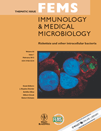‘Real-time’ PCR-based detection of Coxiella burnetii using conventional techniques
Abstract
The diagnosis of Q fever (Coxiella burnetii infection) relies primarily on the serological detection of specific antibodies. Recently, PCR-based methods have been introduced in diagnostic laboratories. Unfortunately, the fastest and most reliable ‘real-time’ detection method, which employs the ‘online’ detection of target nucleotide sequences while the amplification process is still in progress, requires expensive devices and consumables. In this study, we present a simple method that combines the simplicity of conventional PCR with new technical and methodical enhancements, resulting in a fast, specific and easy method for the molecular detection of C. burnetii. A collection of C. burnetii reference strains was tested with the modified conventional gel-based PCR approach applying a particluar PCR buffer (QIAGEN® Fast Cycling PCR kit) and using a closed ready-to-use gel-cassette-system (FlashGel®) for the visualization of specific PCR products. The modified conventional PCR method reached nearly the speed of the LightCycler® HybProbe real-time PCR assay (120 vs. 90 min) and showed equal sensitivity and specificity. The general cost per PCR run was 25% less than that for the LightCycler method. These improvements make this method suitable for small laboratories with limited resources and for deployable PCR diagnostics in field laboratories.




